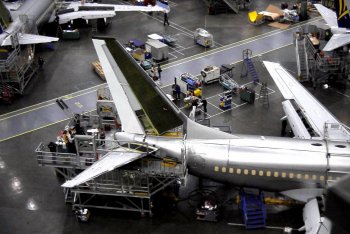|

Member solidarity will play a major role in 2002, just as it did
in the successful 1999 negotiations.
Boeing 2002 Contract Negotiations:
Jobs and Job Security
The IAM’s contract with Boeing expires September 1, but the
battle lines were sharply drawn three years ago when members
ratified the current agreement.
“Jobs and Job Security -- that’s issue number one,” explains
Dick Schneider, IAM Aerospace Coordinator for Boeing. “That was
the issue in 1999, that was the issue when we struck Boeing in
1995 and that remains the central issue today.
Boeing continues to aggressively eliminate jobs in open
violation of the contract,” said Schneider. In 1999, the IAM’s
“master agreement” with Boeing covered 49,000 members: 36,000 in
Washington state, 11,500 in Wichita, KS and 1,800 in Portland,
OR. Three years later, it covers only 25,377 members: 19,500 in
Washington, 4,827 in Wichita and 1,050 in Portland.
“Boeing employed 44,000 IAM members in the Puget Sound in 1990,
when they delivered only 290 airplanes. They delivered 450
planes last year, but only employed 28,000 of our members here
in Washington. What happened to all those jobs? Boeing sent them
overseas and subcontracted the work to non-union vendors and
suppliers. Their plan is to eliminate everything but design and
final assembly, and we say that is going to kill this company,”
Schneider said.
We Won’t Run
“Boeing may be running away to Mexico and China, but we’re
not running anywhere. We will fight in court, in negotiations,
in Congress and on the picket lines,” said General Vice
President Bob Thayer, who heads the IAM Aerospace Department.
“We are making a stand right here, for the future of our kids
and our communities. This is a fight for survival.”
Looking at the employment numbers, you might think Boeing is
losing money. But you would be wrong. Boeing’s total sales
soared 27% during the past five years to $5.82 billion. The
company’s net (or after-tax) profits have more than doubled
since 1998, leaping from $1.12 billion to $2.83 billion.
Battle Line: Pensions
Under the current contract, a member with 30 years’ service
would retire on roughly $18,000 a-year. “That’s not good
enough,” said Schneider. “That’s not even close.”
“The Boeing pension plan is so over-funded, the company hasn’t
had to put in a dime since 1997. That’s the member’s money, not
Boeing’s,” said Schneider.
“We want that money used to improve benefits, but Boeing is
letting it sit there, piling up interest, to make their balance
sheets look fatter,” he said.
Membership surveys show improved pension benefits are the second
most important issue this contract, just behind job security.
“We need a higher basic benefit, a better early retirement
package plus a pension supplement through the IAM National
Pension Plan,” Schneider said.
Battle Line: Health Care
“The IAM and Boeing have a joint committee dedicated to
improving care and holding down or lowering costs. The IAM wants
to continue in that direction, towards better and better care at
the same or lower costs to our members. If Boeing plans to break
with us and go in a different direction, they will have a fight
on their hands,” Schneider said.
“The issues we face at Boeing are shared by millions of working
families across North America. People are desperately worried
about their jobs and jobs for their children. Every month, tens
of thousands of families are losing their health care coverage
or facing retirement with too little to live on. We are fighting
not just for ourselves, but for millions of people who need
someone to hold the line, who need to be shown that real
solutions do exist to these problems,” Thayer explained.
“These issues affect our kids and your kids. They affect our
community and the industrial future of all North America, and
that’s how we are going to build this fight —— as a
community-wide, nation-wide campaign for decent jobs, affordable
health care and secure retirements,” said Thayer.

Boeing’s increasing use of offshore parts, such as Chinese-
made
sections of the tail assembly being attached below,
is costing
thousands of North American jobs.
 |
|